Foreword - 13 animated presentations follow, to adapt to other game systems with no problems
Pure theory instruction - like space allocation on a small field, - a worse mistake, and nevertheless constantly asked about thereafter. Why is this so? Is it really a mistake? I believe it is like many things: It comes down to the observer and the reasons for theory instruction on a small field.
Once more we take a look at the development in soccer:
There are "older" soccer players according to whom theory instruction should be offered following the "Principles of optimal soccer training."
Another important reason why there is demand again and again for tactics instruction on a small field is the irresistible orientation to the ball among the young. For a layman watching a game, a reason to doubt again and again the technical know-how of the trainer. It is actually thus not clear to many youth trainers that there are more important things for soccer kids to learn.
Introduction
In order to give due consideration to the points above, I have shown here forms of practice for space allocation. These forms of practice are not tactical ways of kicking the ball around, but they concern making space allocation on a small field an essential feature. After a very brief theoretical part, learning is presented about forms of playing.
- I myself have successfully performed the practices with female teams.
- I won't go into detail, but will only show the fundamentals of field allocation clearly.
- I have used 3-3 as the example of the game system. The 3-3 system is not wholly undisputed, but is usually encountered on the small field. However, the practicing can be carried over to any other game system with no problems.
Basics of space allocation
To be able to start the practice, divide the small field into 9 equal fields (with marker plates) (Graphic 1).
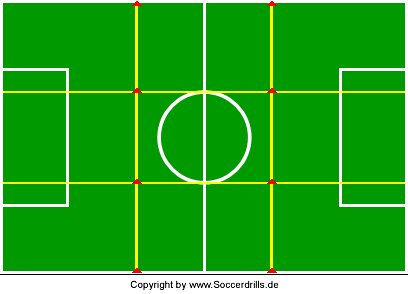
Graphic 1
Zone division
Then we have three zones: Defense zone, centerfield (central zone), offense zone. Each of these three zones is divided into a left, central, and right playing field (Graphic 2).
Explain this classification exactly to your team so that all players are well informed about the field. A coach board is eminently suitable for this. 10 minutes and the matter is taken care of.
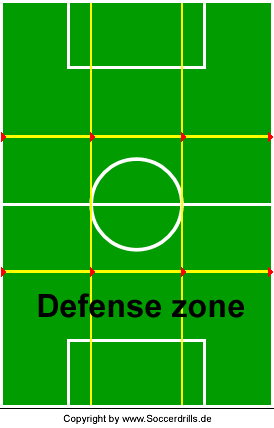
Graphic 2
Now off we go!
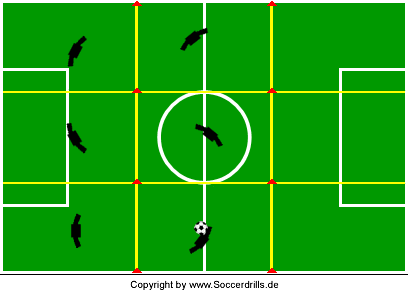
Graphic 3
As another aid to explanation you can have balls passed through the zones (Graphic 3) and make this interesting by changing places after the pass (Graphic 4).
Each of the six players has a field. When changing places, the players always run into a field that is not occupied. Two teams can also perform these drills at the same time, each with a ball.
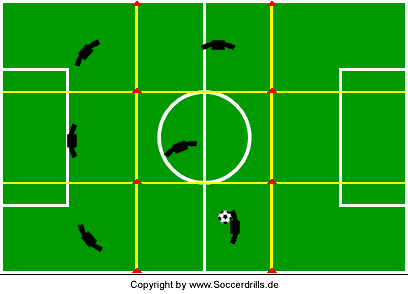
Graphic 4
Defensive short and snappy - Moving to the ball
Now here we go correctly with the space allocation, first in the defensive. 6 players have the defensive and central zones, and the goalie stands in the goal where he belongs. Always be sure when shifting that the goalie also plays along. The times when the goalie sticks to the line or runs around unconcentrated are gone.
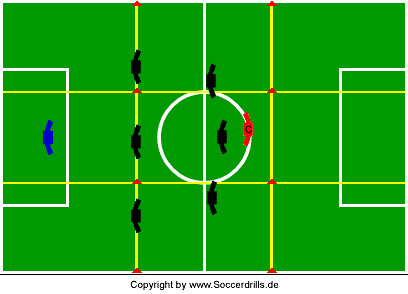
Graphic 5
What is missing is the ball, so that a shift also makes sense. In Graphic 5 the trainer takes over the role of the ball by moving with the ball in the intersection between the central and offense zones. You can see in the animation how the players move around corresponding to the ball. The players first of all leave the zone assigned to them only slightly. Pay attention to the goalie, who also moves around. Carry out this drill for only a short time; it is a "dry drill." As an escalation, the trainer can penetrate even further toward the goal.
Shifting - Safeguarding the backfield
Graphic 6 shows the execution of the prior form of practice without the trainer. For this, three players pass a ball back and forth, and the defensive moves accordingly. The defense is passive. Basically, the farther away an offense player is from the ball, the less important he becomes. Orientation is always toward the ball.
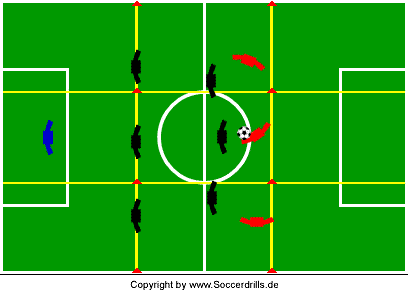
Graphic 6
In the next step, three offense players try to penetrate into the defense zones in order to make a goal. Make a game out of this. Always three attackers versus six defenders. Very unfair, but great success experiences for the defensive. However, there is also a gigantic advantage for the offense: The defenders must not leave the fields assigned to them. Then increase the number of attackers to four and/or five (Graphic 7 = Small play clip). Graphic too offensive? I often tend to exaggerate! The shifting to the ball occurs again and again. This drill is also of interest when you remove the goal and the attackers try to get beyond the baseline with the ball.
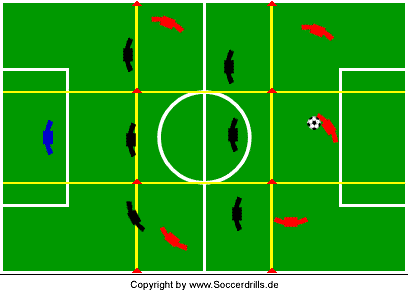
Graphic 7
Important: Up to now each player was responsible only for his limited playing field. Starting now, this is different: Each player is now also responsible for the adjacent fields. The result of this is that the defense near the ball tries to get into the power play. Another effect is securing of the backfield behind the attacking players. Players farther away from the ball are then covered more loosely. The defensive player near the ball immediately attacks the attacker. He calmly tries to play this way over the entire field. First against three, then against four and five attackers. The goalie always plays along!
Defensive game clip
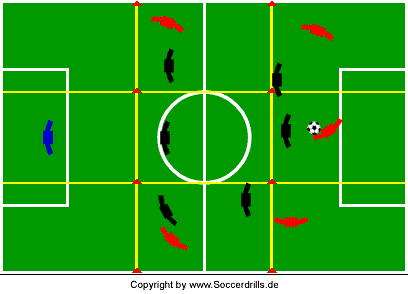
Graphic 8
Graphic 8 = Small game clip = The opposing player attacks already close to his goal, the other defensive players move, assist, and provide passing routes.
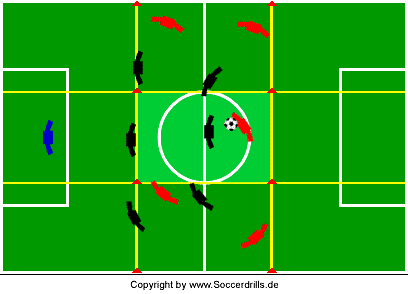
Graphic 9
Graphic 9 = Small game clip = The opposing player attacks in center field. Shift and close passing routes. Pay attention to the depiction of the danger zones.

Graphic 10
Graphic 10 = Small game clip = Opposing player attacks right in front of the goal. High risk of goal! Shift, assist, and safeguard near the ball. At the side distant from the ball, farther away from the opponent, no immediate risk of a goal threatens there. Don't allow any breakout or goal shot.
Attack short and snappy
The players have now comprehended what spaces exist on the small field. What does this mean for the offense? It would be desirable for basic knowledge of the "Cover Shadow" to exist. The team is now able to outplay the opposing defense by a lot of motion and space-overlapping attacks.
There should be no solid defensive, centerfield, and attack behavior on the small field. Depending on the game situation, the team finds itself in offensive or defensive mode, and everyone participates, including the goalie.
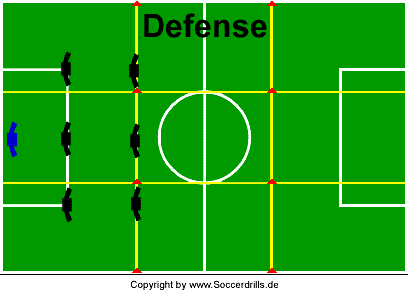
Graphic 11
Pay attention in Graphic 11 to the advances of the team on the attack. In defense, still centerfield and now attack, and in defense, still defense, now centerfield. The players try not to leave any field gaps to occur between ball carrier and coplayers. Always be ready to enter the play, this is important. The horizontal allocation is shown in the animation. The vertical alignment includes wing play. If you have the courage, the goalie can advance even further. This will probably not please everyone, but this is how I picture small-field soccer.
Competition with assignment in space
As practice for this, the players should cross over the playing field and make a goal after the goalie rolls away, within a certain time, or after a given number of passes (Graphic 12 = Guideline = 6 passes in the field, only direct play).
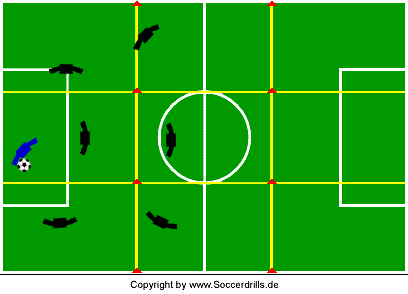
Graphic 12
Particularly effective as a form of competition with timeout. Advance! Play along! Serve! The goalie also guards the backfield. It's a lot of fun when the team comes up with its own sequence of passes.
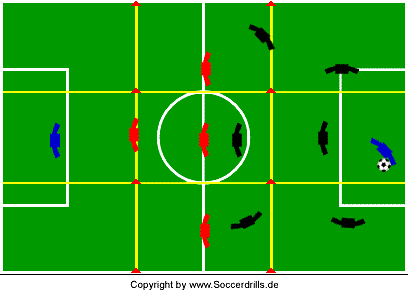
Graphic 13
In the next step we add a defense. First, four players who must move semi-actively only in given spaces (Graphic 13). Then increase the number of defenders to five, until the game is complete.
This can only be an outline of space allocation on the small field. It is a start that has proved useful in practice. Again and again, point to the division of the playing field if there are problems. Children and adolescents internalize the allocation very quickly once it has been presented to them visually.